
CAMP MAGSAYSAY, Philippines — As one of Army Futures Command’s first forays into in-theater persistent experimentation, a team of observers/assessors were in the Philippines looking at the 1st Multi-Domain Task Force’s capabilities in the Pacific.
This Joint Warfighting Assessment, or JWA, team observed the 1st MDTF’s concepts and capabilities during Balikatan 23, a Marine-led exercise. The JWA23 team is led by the U.S. Army Joint Modernization Command and includes experts from various capability development integration divisions. The assessment is meant to build on the lessons learned during past Joint Warfighting Assessments and Project Convergence capstone events. With persistent experimentation, regular assessments like this throughout each year will allow Army modernization and transformation efforts to maintain momentum and speed.
Brig. Gen. Bernard Harrington, commander of the 1st MDTF, underscored the significance of initiatives like JWA23 in shaping the future of the Army in the Indo-Pacific.
“JWA23 is an opportunity to get multiple teams together to figure out how we get the Joint force into position in the Indo-Pacific” Harrington said. “Over the last two years, [U.S. Army Pacific] has steadily increased investments in the first island chain, placing combat-credible forces on key terrain to build interoperability with key partners. JWA23 is one feedback mechanism to evaluate how we prevent conflict and prevail in competition.”
The MDTF is the newest formation in the Army and is at the forefront of Army experimentation. Many of the new capabilities the Army is looking to in the future would come from the MDTF. During JWA 23, the JMC-led team assessed the 1st MDTF’s ability to integrate with joint partners and allies, joint sensor-to-shooter efforts, joint networking and joint force protection. As part of preparing for future conflict, the MDTF is being asked to do things the Army has never done before.
Balikatan is the largest annual bilateral exercise conducted between the Philippines and the United States. This year’s exercise, which took place in late April, was the largest to date, with more than 17,600 participants. Balikatan advances combined military modernization and capability development efforts by providing realistic rehearsals of concept, as well as numerous subject matter expertise exchanges.
From the beginning, the build of the MDTF was designed to be a joint force enabler. Looking specifically at the Pacific, adversaries have spent the past 20 years designing a network to keep out the Army’s joint force partners, focusing on high-flying aircraft and large maritime vessels, said Lt. Col. Ben Blane of the 1st MDTF.
“When we talk about the Balikatan exercise, we do have this relationship with the partners here in the Philippines,” Blane said. “But we’re also bringing in our partners from the U.S. Air Force and the U.S. Marines. We’re connected with our partners afloat in the Pacific and also in our main operations center at Joint Base Lewis-McChord who are helping us with some of these concepts. It’s that partnership, and then together, really building those capabilities forward in the Pacific. So, if we do rise to the point of conflict, we have some survivable positions here that can support the joint force.”
The Joint Modernization Command and its Joint Warfighting Assessments have been important to the MDTF’s experimentation and development from the start, Blane said. And as part of AFC’s persistent experimentation efforts, JWAs continue to be an integral part of developing the right capabilities with the right people for the future of competition and warfare.
“To take you all the way back to JWA19, the assessors saw the value in filling some of these gaps that we were talking about,” he said. “There was a quote in the final document that said the Army needs to immediately prioritize this formation and get into both PACOM and EUCOM as fast as possible. You saw the activation of the MDTF soon after.
“Bringing in this team here during JWA23, we refine these ideas, talk about these concepts, talk about the things we’re learning, and then get it through that other lens where we’re bringing in experts with the JMC team and all of the Army Modernization Enterprise,” Blane said. “We’re really honing in on what we’re doing here, why it’s important and then taking that refined message and then being able to push that back out to the rest of the force. That’s huge. And I’ll tell you what, the Soldiers are super excited about what they’re doing.”
MDTF experimentation is critical to getting the formations and capabilities of future warfare correct. Joint and Combined multidomain operations are key to the future, and the MDTF is at the cutting edge of that concept.
By Jonathan Koester

